ChangSha Wares
 Changsha kiln, also termed Tongguan kiln,was a famous Southern China Tang Dynasty kiln. Based on archaeological findings, Changsha wares were developed from the foundations of the Yuezhou wares [not to be confused with Yue wares, same pronunciation but different character], a Tang celadon ware of Hunan. Both were mentioned in the Tang poet Lu Yu' treatise on tea with Yue wares of Zhejiang rated the best.
Changsha kiln, also termed Tongguan kiln,was a famous Southern China Tang Dynasty kiln. Based on archaeological findings, Changsha wares were developed from the foundations of the Yuezhou wares [not to be confused with Yue wares, same pronunciation but different character], a Tang celadon ware of Hunan. Both were mentioned in the Tang poet Lu Yu' treatise on tea with Yue wares of Zhejiang rated the best.

 Changsha wares are usually associated with the painted brown and green and/or applique motifs on vessels covered with a straw colour transparent glaze. The colour of the glaze actually varies from a straw colour to a creamy yellowish white. The glaze surface ranges from a transparent brightness to a somewhat cloudy finish. A white slip is usually applied to conceal the coarse body before the glaze is applied on the vessel. The glaze has a tendency to peel off some areas of the vessels, especially those painted brown. The glaze usually have fine crazings.
Changsha wares are usually associated with the painted brown and green and/or applique motifs on vessels covered with a straw colour transparent glaze. The colour of the glaze actually varies from a straw colour to a creamy yellowish white. The glaze surface ranges from a transparent brightness to a somewhat cloudy finish. A white slip is usually applied to conceal the coarse body before the glaze is applied on the vessel. The glaze has a tendency to peel off some areas of the vessels, especially those painted brown. The glaze usually have fine crazings.
The paste is usually grayish in tone but examples with buff or varying brick colour tones could also be found.
Polychrome decoration
 The Tang period is usually associated with production of monochrome white wares in the North and celadon wares in the South. The Changsha potters were the pioneers in successfully introducing high fired polychrome decorations. Hence, Changsha wares held an important place in the history of chinese ceramics. The colours were produced by mixing lime-glaze with copper or iron oxides. These new coloured glazes were splashed, trailed, brushed and painted on the vessels which were first covered with lime glaze. By firing the wares under oxidising atmosphere, copper oxide glaze turns green, and iron oxide amber-brown or purple-brown with a manganese-iron pigment. There were some rare successful examples of copper red which could only be produced in reduction firing atmosphere.
The Tang period is usually associated with production of monochrome white wares in the North and celadon wares in the South. The Changsha potters were the pioneers in successfully introducing high fired polychrome decorations. Hence, Changsha wares held an important place in the history of chinese ceramics. The colours were produced by mixing lime-glaze with copper or iron oxides. These new coloured glazes were splashed, trailed, brushed and painted on the vessels which were first covered with lime glaze. By firing the wares under oxidising atmosphere, copper oxide glaze turns green, and iron oxide amber-brown or purple-brown with a manganese-iron pigment. There were some rare successful examples of copper red which could only be produced in reduction firing atmosphere.
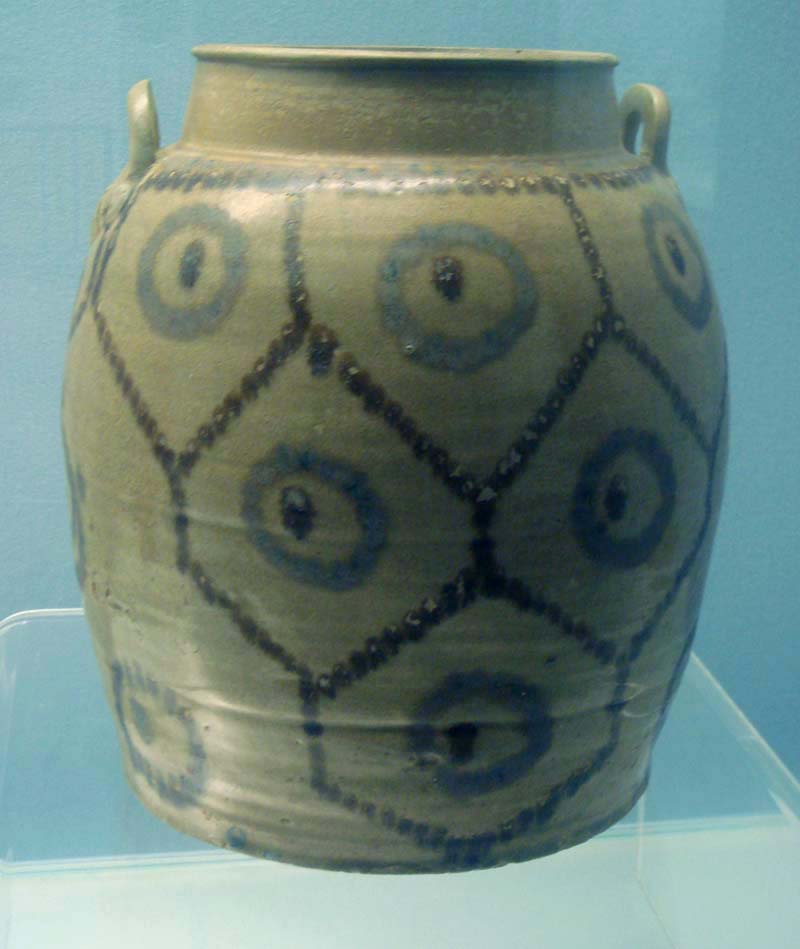
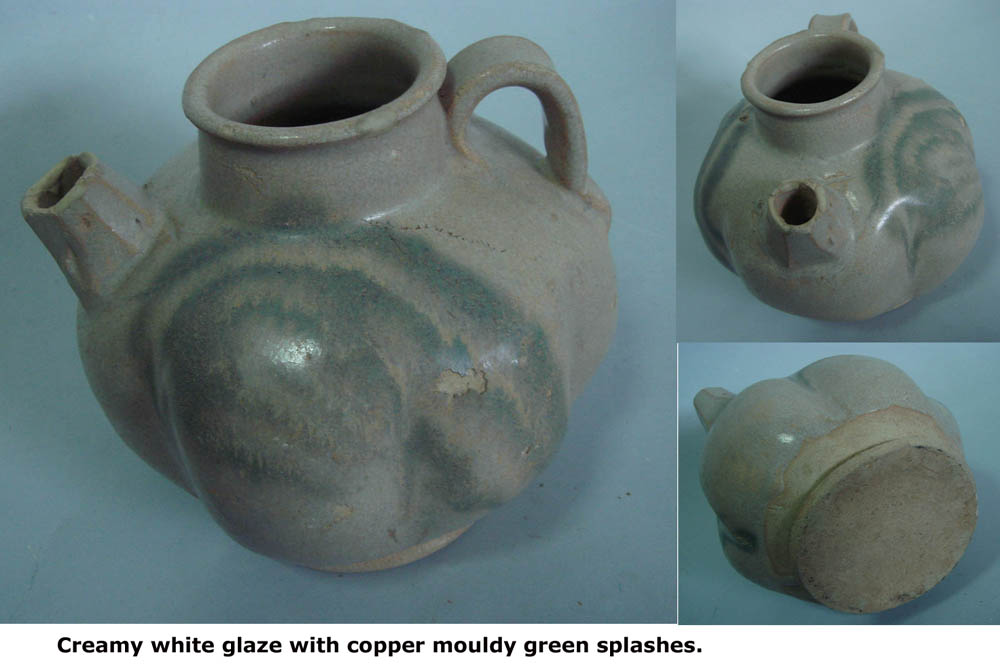 In addition to the transparent lime glaze, Changsha wares also used a milky-white lime glaze. According to Nigel Wood, such glaze is "rich in oxides of phosphorous and low in alumina that separated in cooling into immiscible glasses. These glass-in-glass emulsions scattered white light and gave the glazes a milky cast. The white and creamy glazes of Tongguan made excellent light-coloured grounds for decoration in trailed green, brown and purple brown".
In addition to the transparent lime glaze, Changsha wares also used a milky-white lime glaze. According to Nigel Wood, such glaze is "rich in oxides of phosphorous and low in alumina that separated in cooling into immiscible glasses. These glass-in-glass emulsions scattered white light and gave the glazes a milky cast. The white and creamy glazes of Tongguan made excellent light-coloured grounds for decoration in trailed green, brown and purple brown".
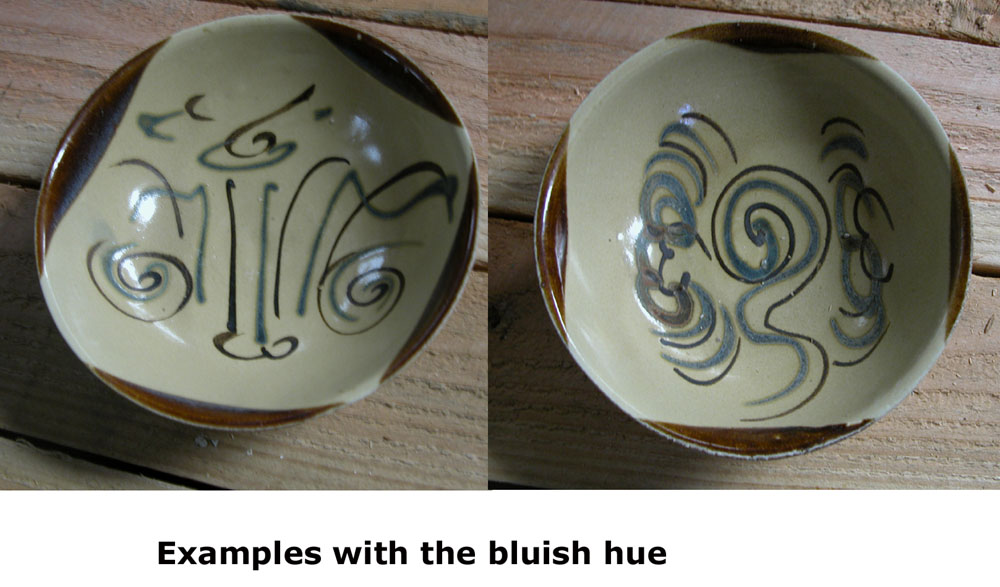 Usually when the copper oxide glaze is applied on the milky white glaze, it gives a mouldy green hue. However, sometime a mouldy bluish green hue is produced. This is a form of optical blue and not to be confused with actual blue produced by cobalt.
Usually when the copper oxide glaze is applied on the milky white glaze, it gives a mouldy green hue. However, sometime a mouldy bluish green hue is produced. This is a form of optical blue and not to be confused with actual blue produced by cobalt.
Painted motifs
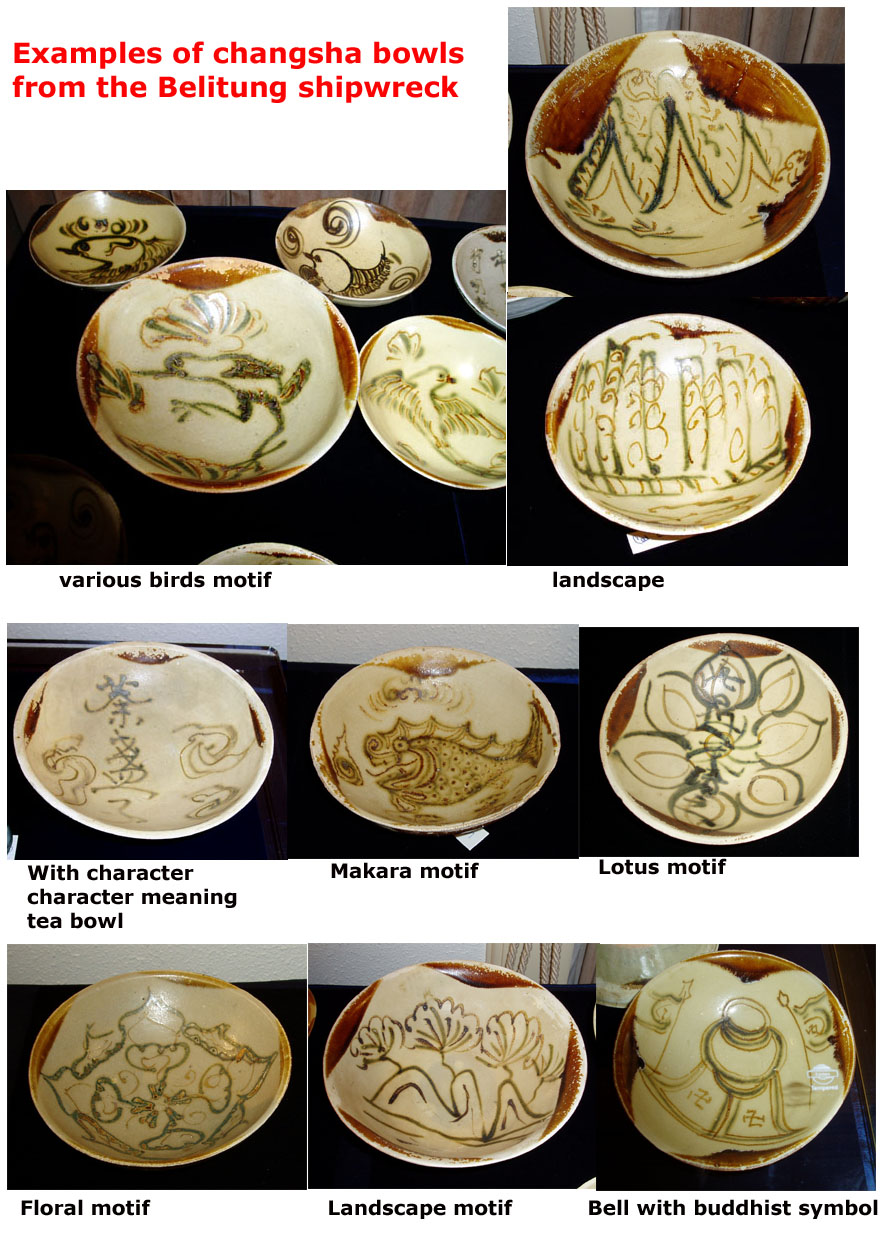 The Tongguan potters successfully applied the iron brown and copper green pigments to paint a wide variety of motifs, such as calligrapy, flowers, fish, children playing, birds, landscape, abstract looking motif and etc. Many of the motifs showed buddhist or Islamic influence.
The Tongguan potters successfully applied the iron brown and copper green pigments to paint a wide variety of motifs, such as calligrapy, flowers, fish, children playing, birds, landscape, abstract looking motif and etc. Many of the motifs showed buddhist or Islamic influence.
Applique Motifs
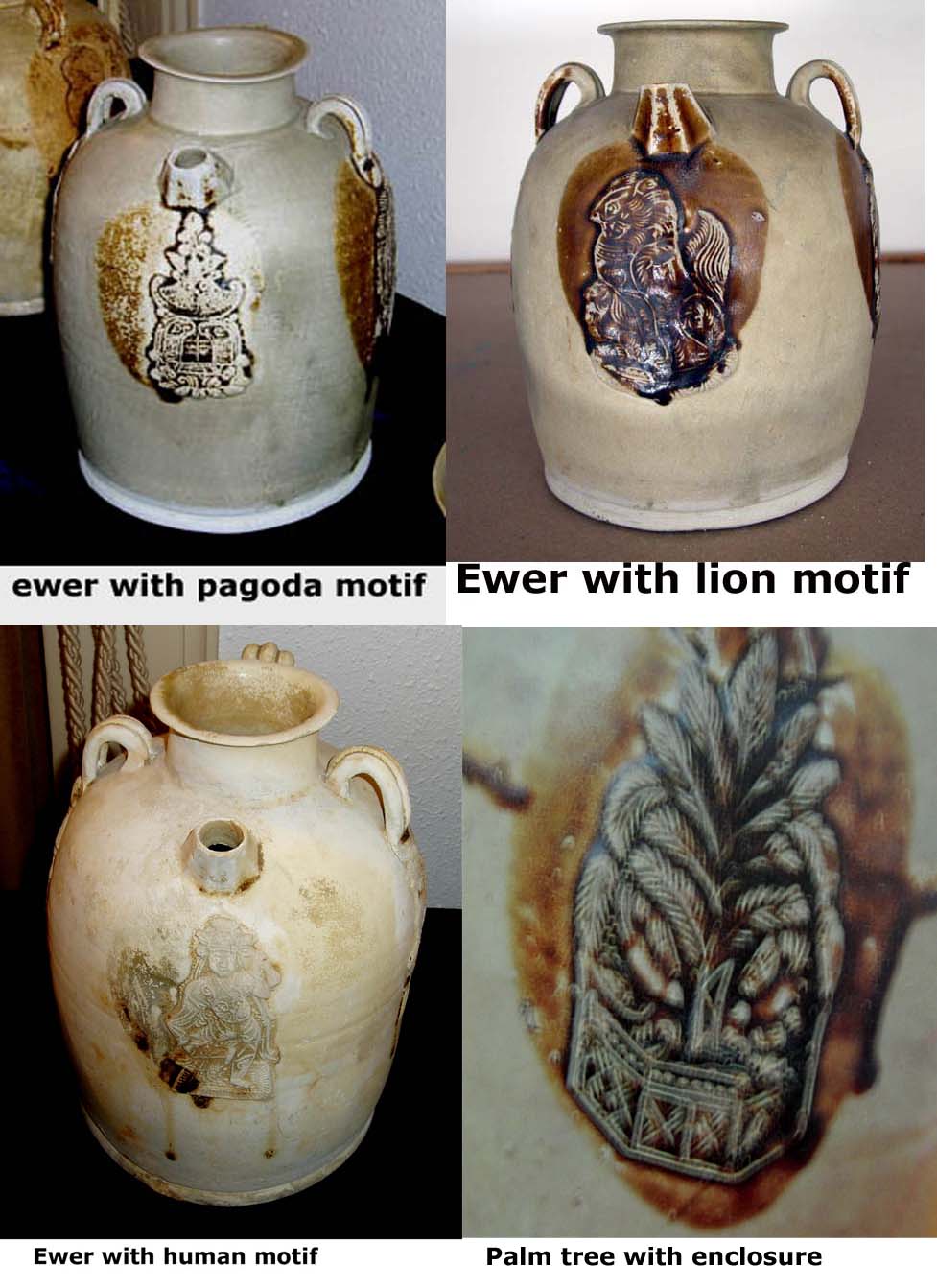
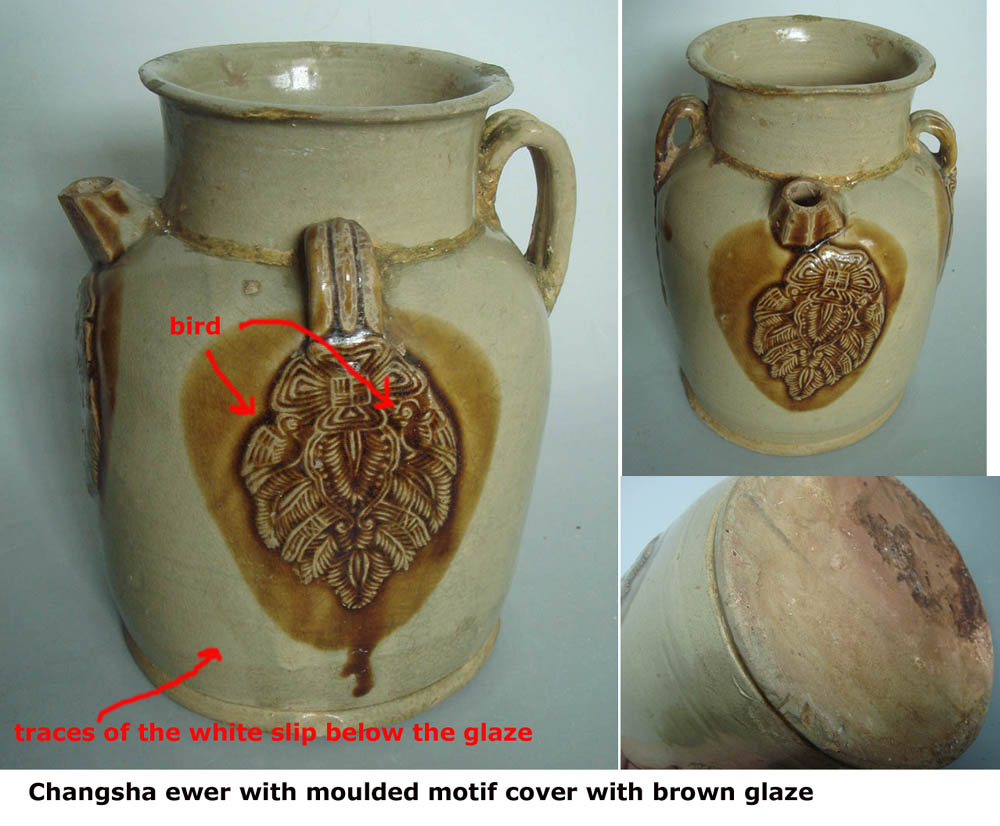 Another decorative techniques involved the application of darkish brown glaze, often over molded decorations luted onto ewers. The molded elements included palm like tree, paired birds, lions, human motif, pagoda and etc
Another decorative techniques involved the application of darkish brown glaze, often over molded decorations luted onto ewers. The molded elements included palm like tree, paired birds, lions, human motif, pagoda and etc
Polychrome motif, underglaze or overglaze ?
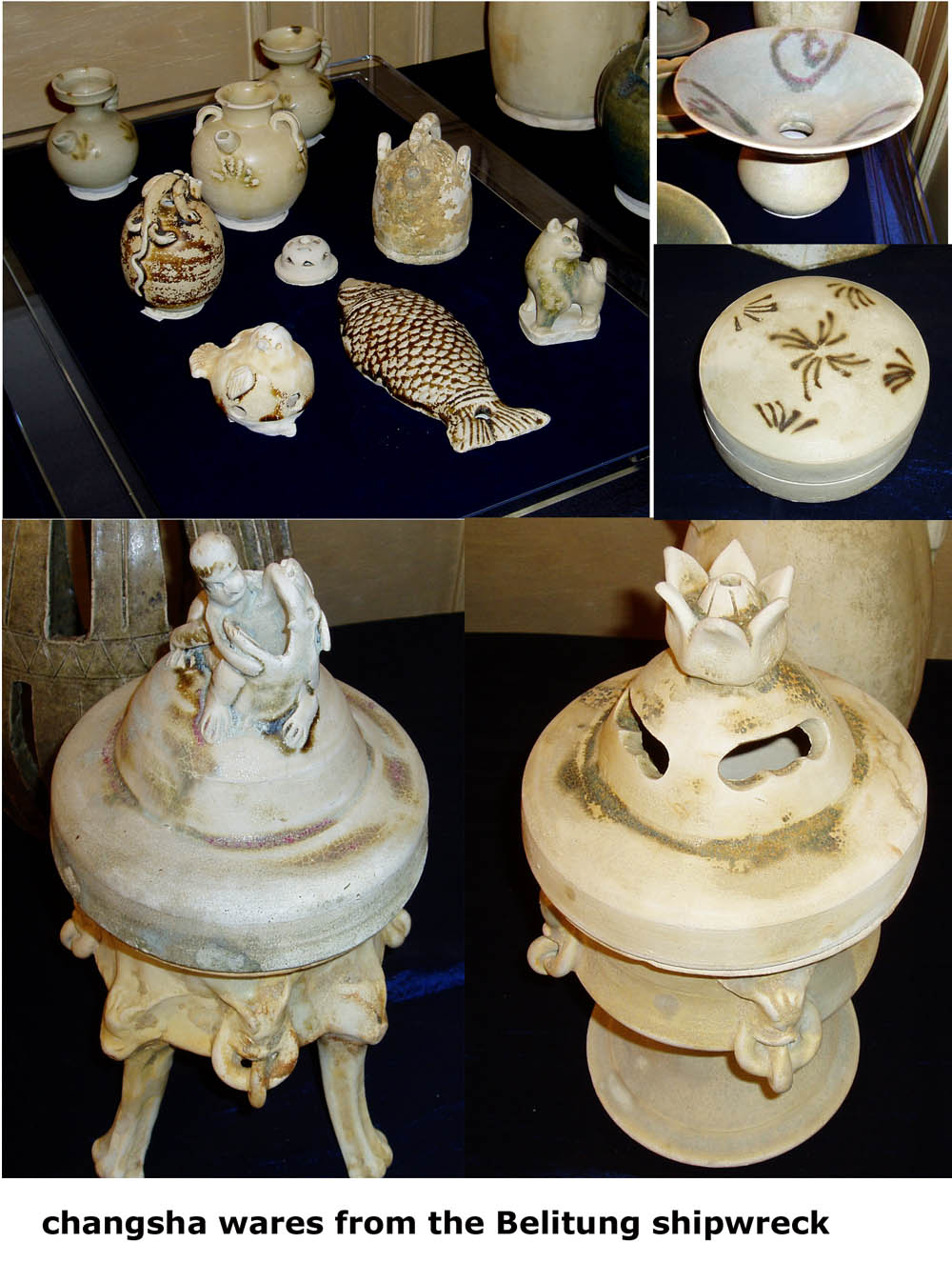 Currently, there is still no consensus on whether the polychrome decoration on Changsha is underglaze or overglaze. Prof. Zhou ShiRong, an expert on Hunan ceramics, is of the view that the motifs are underglaze based on physical inspection of the shards. Extensive study by Prof Zhang Fu kang of the Shanghai Institute of Ceramics showed that the designs on Changsha wares are mostly coloured glaze applied over the transparent glaze. According to him this is obvious when examining the cross section of Changsha samples. They do not show traces of the pigments on the surface of the body as oppose to those found on the under-glaze cizhou or early blue and white decoration. Typical underglaze ware has a layer of transparent glaze above the pigments but this is not found on Changsha painted wares. For Changsha wares, the pigment could be seen on the top and mid layer of the glaze but not on the under-layer. Some western scholars term them as in-glaze colours.
Currently, there is still no consensus on whether the polychrome decoration on Changsha is underglaze or overglaze. Prof. Zhou ShiRong, an expert on Hunan ceramics, is of the view that the motifs are underglaze based on physical inspection of the shards. Extensive study by Prof Zhang Fu kang of the Shanghai Institute of Ceramics showed that the designs on Changsha wares are mostly coloured glaze applied over the transparent glaze. According to him this is obvious when examining the cross section of Changsha samples. They do not show traces of the pigments on the surface of the body as oppose to those found on the under-glaze cizhou or early blue and white decoration. Typical underglaze ware has a layer of transparent glaze above the pigments but this is not found on Changsha painted wares. For Changsha wares, the pigment could be seen on the top and mid layer of the glaze but not on the under-layer. Some western scholars term them as in-glaze colours.
More information on Changsha wares
For more information on Changsha wares, please read below article
Changsha wares found in Belitung shipwreck